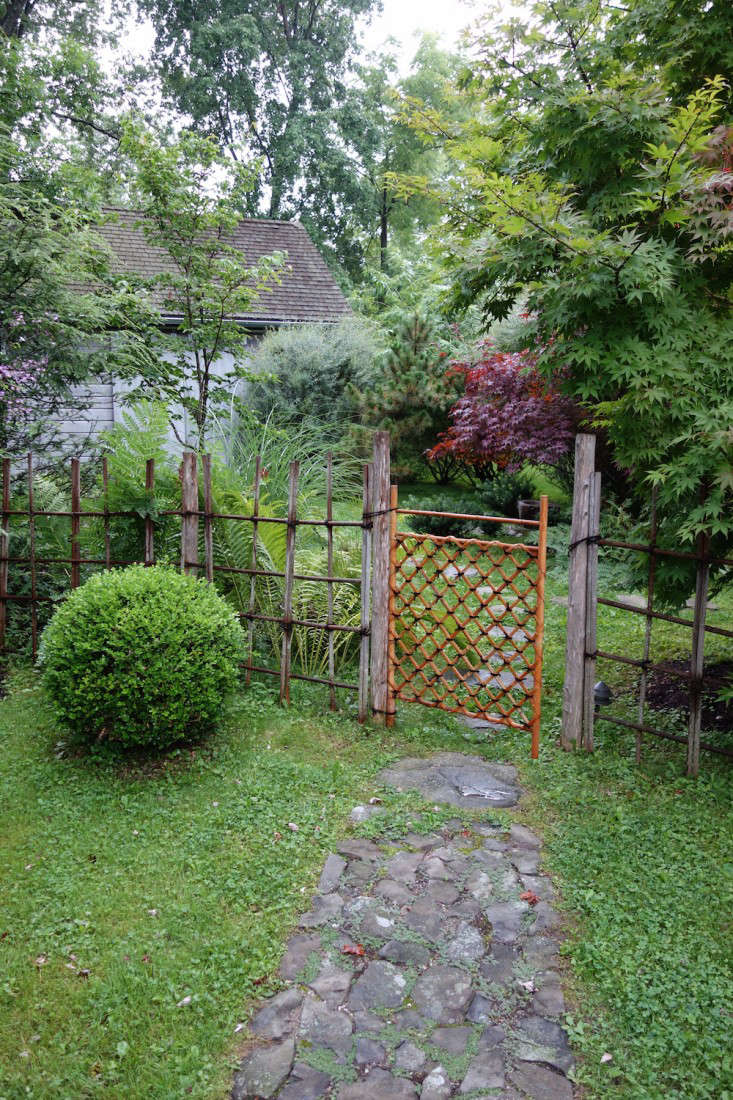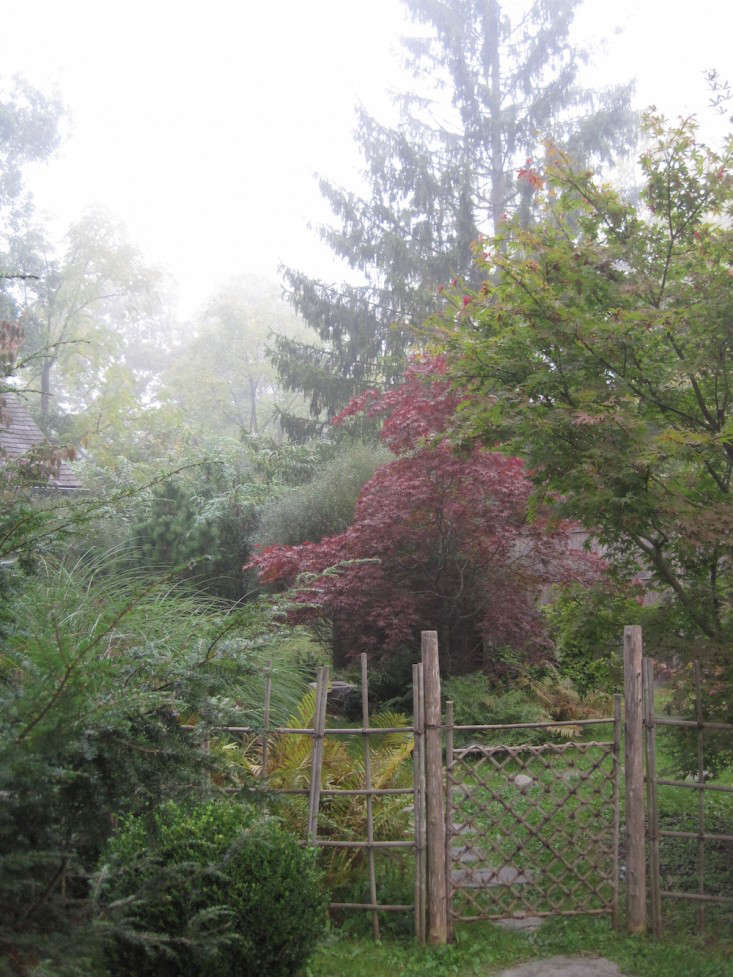The winner of this year’s Gardenista Considered Design Awards Best Amateur-Designed Garden is Bettina Mueller of Tivoli, New York.
Her project was chosen as a finalist by Gardenista editor in chief Michelle Slatalla, who said: “The use of simple, rustic materials reinforces the beauty of the natural surroundings.”
N.B.: This is the fourth of seven posts spotlighting the winners of the 2015 Gardenista Considered Design Awards. Go to this year’s Considered Design Awards page to see all the entries, finalists, and winners, and have a look at Remodelista’s Considered Design Awards, too.

Bettina Mueller’s Design Statement: “Drawing from her decades-long study of the Japanese Tea Tradition where great–even legendary–gardens are small by necessity, Bettina Mueller sets out to turn her backyard in the small Hudson Valley village of Tivoli, New York into a private world of beauty and tranquility.”

Q: Where do you live?
A: I live in an 1860s Victorian house on a quarter of an acre in the small Hudson Valley village of Tivoli, New York. Tivoli is a rural village of about 1,100 people, two hours north of New York City. I can walk into town for Mexican, Japanese, or bistro food and to visit the post office, artist co-op, or library, but I have to drive five miles to the grocery store. At Bard College, which is five minutes away, the Frank Gehry-designed Fisher Center for the Performing Arts hosts dance and theater companies from around the world.

Q: What were your practical goals for the project?
A: In 2005 I built a small tea house in the backyard which had no trees or plantings. It was a bare patch of ground surrounded by neighbors. Drawing from my decades-long study of the Japanese tea ceremony tradition, where great–even legendary–gardens are small by necessity, I set out to build a roji–a traditional tea garden–to lead to the tea house. My challenge was to make it feel as though it had always been there.

Q: What solutions did you find to your design problems?
A: There are a number of design elements that make a roji or tea garden work, and I incorporated these concepts into my garden so that they didn’t look out of place in my Victorian village. Gates and fences play an important role in defining the two main garden rooms: the outer roji and inner roji. I hand-built the bamboo fence that separates the two rooms and tied the poles together with black hemp. This is a traditional fence you would find in Japan, but it is so lightly constructed that it merges into the garden and gives just a suggestion of barrier. Another important element is the two stone paths that define the garden. In the outer roji, the path is straight and cobbled. Once through the wicker gate, the path changes to scattered stones.
Besides the tea house, there are two important destinations in the garden: a waiting bench and a stone water basin for rinsing one’s hands before a tea ceremony. The planting is mostly evergreen with non-flowering deciduous trees and shrubs. There are ferns and grasses that lend the feel of a path through the mountains. They say the way to the tea house should feel as though you leave the dust of the world behind.

Q: What are your favorite features of the project?
A: I built the cobblestone path in the outer roji from stones I gathered from an old wall on my mother’s property nearby. I dug a trench 8 inches deep and filled it with 800 pounds of rock dust and sand, then pieced the stones together like a jigsaw puzzle. I then planted creeping thyme to fill in the cracks.
The great tea master of the 16th century, Sen Rikyu, said that the design of the roji should be 60 percent practical and 40 percent aesthetic. He also said that a tea garden could be made more intimate by using materials that have personal resonance. My mother’s house has long been gone, but I am reminded of her every time I walk this path.
Q: What were the hardest lessons you learned along the way?
A: If I hadn’t been careful, I would have covered every inch of my small property with flowers, trees, and shrubs. But there is something refreshing about pulling back, becoming more simple, and watching the natural rhythm of the landscape unfold. I learned restraint and allowed the understated to be revealed.
Q: What was your biggest splurge?
A: The antique Chinese stone water basin. It was formerly used as a mortar and pestle.
Q: What projects would you tackle if you had an unlimited budget?
A: I love the idea of creating a secret garden, an intimate space of tranquility. I would build tea houses and the gardens that surround them. My favorite interior designer, Axel Vervoordt, has a tea house in a rhododendron grove at his castle in Belgium. Projects like that appeal to me. Creating something unique within the traditional.
Q: Where do you get your design inspiration?
A: I have practiced the Way of Tea for many years. This study includes flower arranging, garden design, architecture, literature, the connoisseurship of the fine and applied arts, and cuisine. But even more than this, the Way of Tea is an attitude and perception of what makes something beautiful. Tea practice informs my life. It influences the way I arrange flowers in my house, choose plates and dishes for the food I cook, and the way I design my gardens. Through the practice of tea I have developed an appreciation for an understated, elegant beauty.
Q: Which garden designers, gardeners, or landscape architects do you admire?
A: My favorite garden designers are Piet Oudolf and Dan Pearson. I love their naturalistic planting styles. Oudolf’s High Line in NYC is an amazing place, as is my favorite of his designs, the Lurie Garden in Chicago. I also really admire the cottage garden style and topiary of Arne Maynard. I would love to have a place like his Allt-y-bela. I would still make a hidden tea garden somewhere, just like I’ve done in Tivoli, but would enjoy all that topiary and landscaping.
Above: In June, Mueller published a book on her gardening journey as a student of the Japanese Way of Tea. A Tea Garden in Tivoli is currently available for $28 (down from $34.95) on Mueller’s website, Tea Garden Book.














Have a Question or Comment About This Post?
Join the conversation (0)